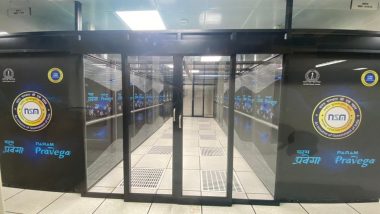The supercomputers in India have got a new sibling, and that is the most powerful supercomputer in India, with a supercomputing capacity of 3.3 petaflops (1 petaflop equals a quadrillion or 1015 operations per second). Named as Param Pravega, this supercomputer is the largest in any Indian academic institution. This is commissioned in the Indian Institute of Science (IISC) in Bengaluru.
According to the institute “majority of the components used to build the system have been manufactured and assembled within the country, along with an indigenous software stack developed by C-DAC, in line with the Make in India initiative”. Meta Claims Its AI Supercomputer Will Be the World's Fastest.
IISC's Tweet
Param Pravega, among the most powerful supercomputers in India (3.3 petaflops), has been installed at IISc under National Supercomputing Mission. Many components manufactured & assembled in India, including indigenous software stack developed by @cdacindiahttps://t.co/BIyOPSgwkw pic.twitter.com/WDifsRnx1r
— IISc Bangalore (@iiscbangalore) February 3, 2022
The supercomputer has been commissioned in the institution under the National Supercomputing Mission (NSM) to power diverse research and educational pursuits from across the country. The NSM has so far established 10 supercomputer systems across India with a cumulative computing power of 17 petaflops.
The National Supercomputing Mission was launched to enhance the research capacities and capabilities in the country by connecting them to form a Supercomputing grid, with National Knowledge Network (NKN) as the backbone.
The NSM is setting up a grid of supercomputing facilities in academic and research institutions across the country. Part of this is being imported from abroad and part built indigenously. The Mission is being jointly steered by the Department of Science and Technology (DST) and the Ministry of Electronics and Information Technology (MeitY) and implemented by the Centre for Development of Advanced Computing (C-DAC), Pune, and the Indian Institute of Science (IISc), Bengaluru.
PARAM Shivay was the first supercomputer assembled indigenously, was installed in IIT (BHU), followed by PARAM Shakti, PARAM Brahma, PARAM Yukti, PARAM Sanganak at IIT-Kharagpur IISER, Pune, JNCASR, Bengaluru and IIT Kanpur respectively.
India is fast emerging a leader in high power computing with the National SuperComputing Mission (NSM) boosting it to meet the increasing computational demands of academia, researchers, MSMEs, and startups in areas like oil exploration, flood prediction as well as genomics and drug discovery.
According to the IISC statement “These systems have greatly helped faculty members and students carry out major R&D activities, including developing platforms for genomics and drug discovery, studying urban environmental issues, establishing flood warning and prediction systems, and optimising telecom networks,”.
Back to Param Pravega. Param Pravega is a supercomputer part of the High-Performance Computing class of systems, which is a mix of heterogeneous nodes, with Intel Xeon Cascade Lake processors for the CPU nodes and NVIDIA Tesla V100 cards on the GPU nodes. This machine hosts an array of program development tools, utilities, and libraries for developing and executing High Performance Computing (HPC) applications.
The IISC Bengaluru already has a cutting-edge supercomputing facility established several years ago. In 2015, the Institute procured and installed SahasraT, which was at that time the fastest supercomputer in the country. SahasraT, which was at that time the fastest supercomputer in the country. The facility is being used by students and faculty to carry out research in various impactful and socially-relevant areas.
The research conducted by the SahasraT supercomputer revolved around Covid-19 and other infectious diseases. This included modelling viral entry and binding, studying interactions of proteins in bacterial and viral diseases, and designing new molecules with antibacterial and antiviral properties.
According to the IISC statement “Researchers have also used the facility to simulate turbulent flows for green energy technologies, study climate change and associated impacts, analyse aircraft engines and hypersonic flight vehicles, and many other research activities. These efforts are expected to ramp up significantly with Param Pravega”.
(The above story first appeared on LatestLY on Feb 03, 2022 09:36 PM IST. For more news and updates on politics, world, sports, entertainment and lifestyle, log on to our website latestly.com).













 Quickly
Quickly




















